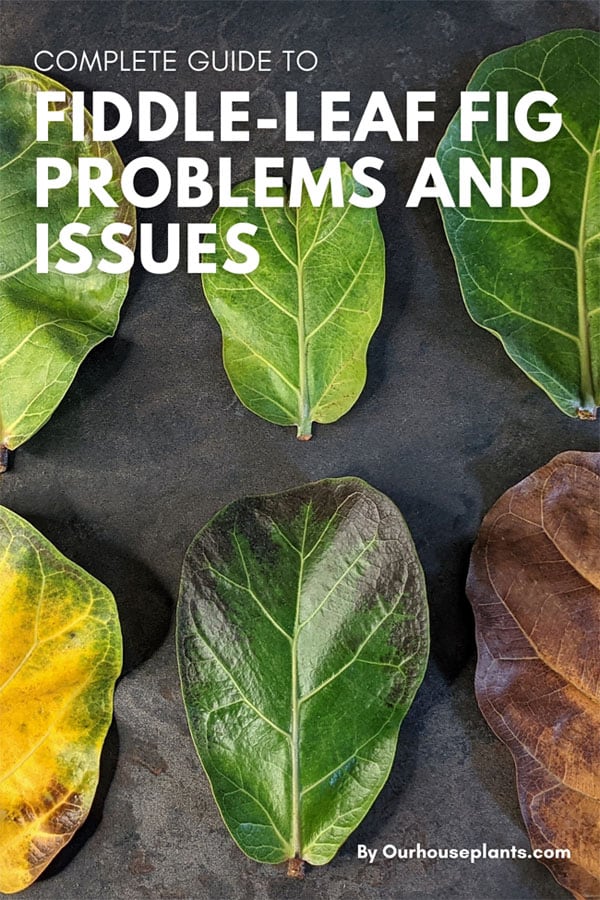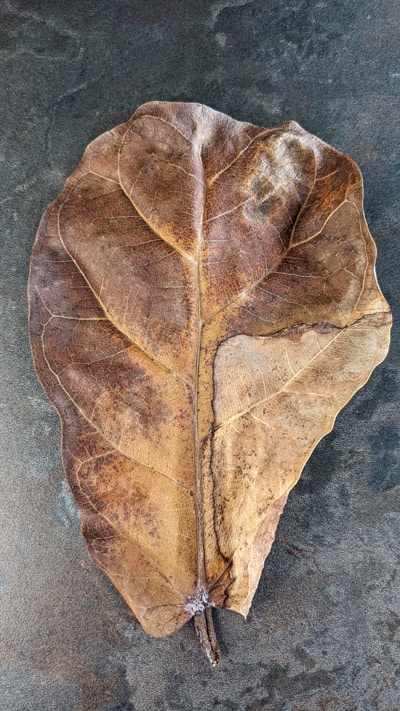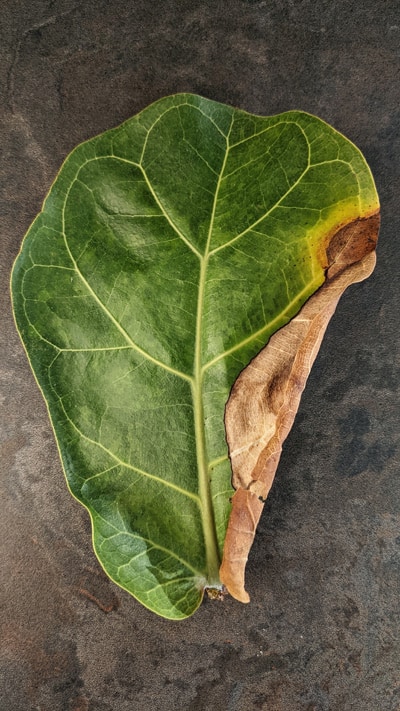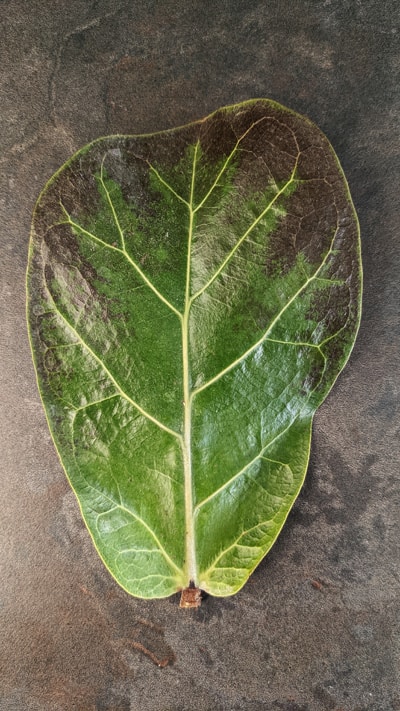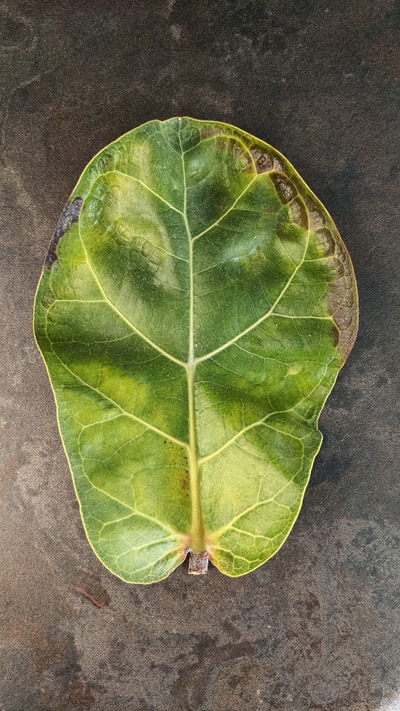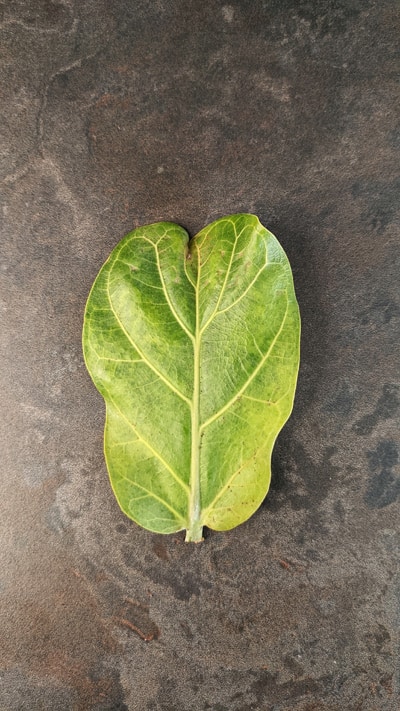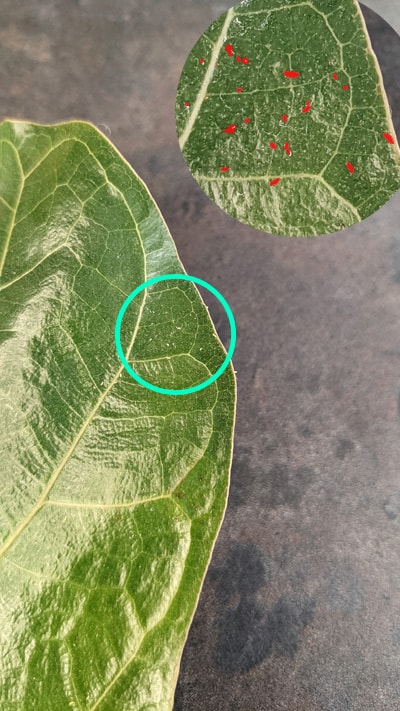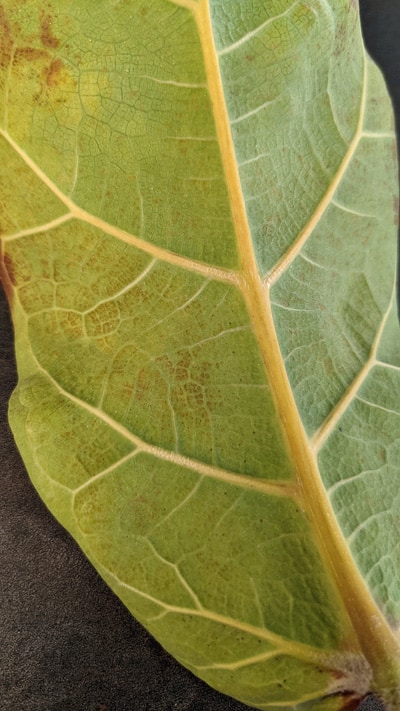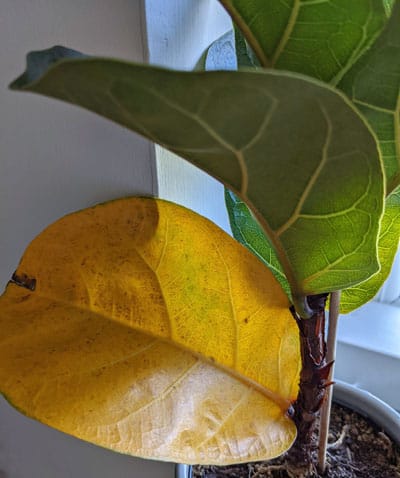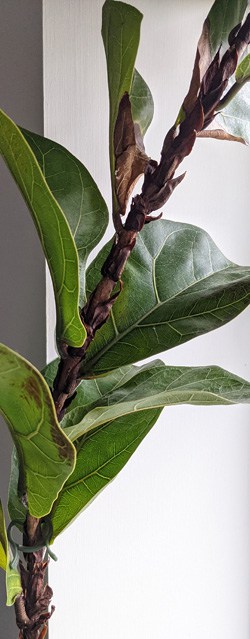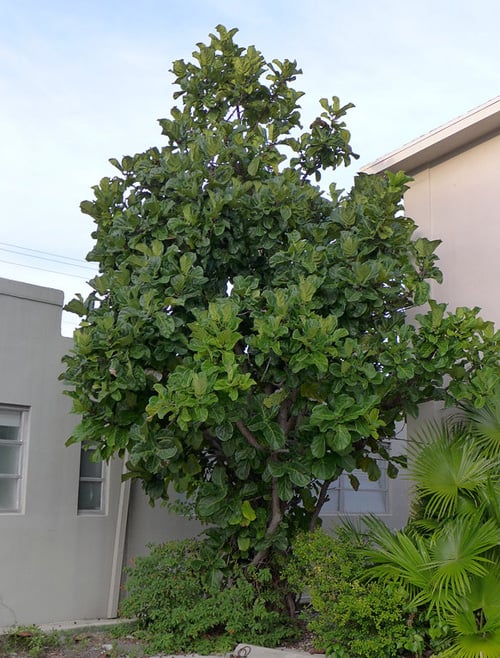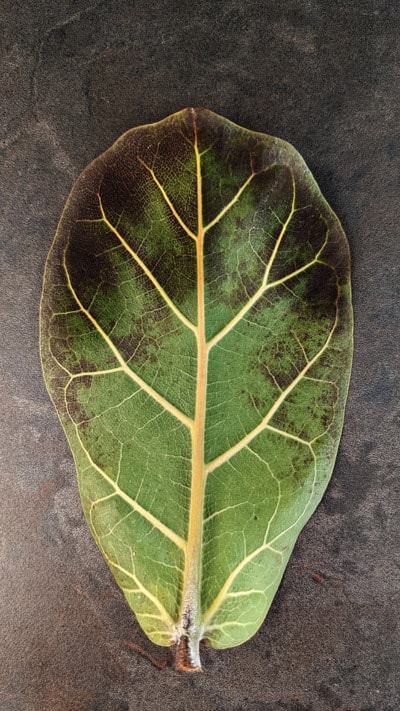Complete Guide to Fiddle-Leaf Fig Problems and Issues
By Tom Knight
Your Fiddle Leaf Fig Problems Solved
Fiddle Leaf Fig problems and issues are a common occurrence. It's all part of owning these majestic and popular houseplants!
Quick growing and pretty easy going when you get the care needs right. But mess up with these and those Fiddle Leaf Fig leaves will drop, change color or just look plain awful in no time.
The good news is that if you fix the cause of the issue, these plants will recover quickly. And this guide will let you identify what's gone wrong and help you solve the problem.
Six leaves showing six common Fiddle Leaf Fig problems
If you're new to this houseplant, you should spend some time reading up how to care for it. Doing this should stop further issues.
Of course, if you've found this post, you've likely already got pressing issues that need to be solved. So let's get on with sorting that first.
Brown and dried leaves
Eventually all Fiddle Leaf Fig leaves will end up like the one below. Completely brown and dry. Once this happens, if the leaf is still attached, you can simply remove it from the plant and discard it.
This leaf is dry and crispy, but it may not be a problem.
Causes
It's the end process of all leaves, so they will only get like this if a problem has gone untreated. These are some of the popular reasons it happens.
- Natural aging.
Lower leaves will go yellow before turning completely brown and drying out. As long as new growth is happening up top, by itself it's not usually a problem that needs correcting.
- You've moved your plant to a brand new area.
Fiddles love consistency, and moving them around to a different location with a change in temperature or light levels can force it to adapt to it's new home. During the adapting process it can lose leaves quite fast. Make sure the new location meets all the required care needs and new growth should start back up in time.
- Something else.
Most issues we cover below can lead to these completely brown leaves after a long period if you don't deal with them. So try and see if there were any other symptoms listed below prior to the leaf getting like this to try and work out what's happened.
Brown Leaf Edges
Brown leaf edges are very common.
This leaf has a brown curling edge which is usually caused by one of three things.
Causes
There are several reasons the edges might go brown and dry up. Try to think back to the care you've been providing, and this should help narrow down which is the culprit.
- Underwatering.
One of the first signs of regular underwatering are the leaf edges going brown and curling.
- General knocking or damage.
Minor knocks to the leaf edges can cause them to go brown and crispy. Although they look tough, the leaves can be sensitive to frequent touching or general brush pass as you walk by. Try and position in less traffic prone areas of your home.
- Low humidity.
As with many houseplants, crispy brown leaf edges are common if the humidity is very low.
Black or Purple Leaf Markings
A couple of things can cause leaves to go black or dark purple like this.
Causes
Leaves going black or dark purple are normally caused by one of two things.
- Cold temperature damage.
If exposed to temperatures below 10°C (50°F) you can expect rapid markings to appear. Sometimes it can happen within a few hours of exposure. Your plant doesn't even need to be outside. If a leaf is pressed up against a cold window during Winter this can happen too.
- Prolonged overwatering.
Too much water around the roots for a prolonged period can cause the leaves to go like this. If you investigate, you may find the soil is very wet and if you pull the plant from its pot you may notice some of the roots could be mushy or rotten.
It should be easy to work out what's happened. For example, has it been cold recently? Did the markings occur quickly or over a long period?
Discolored leaves
Don't believe that ALL your Fiddle Leaf Fig leaves should be perfect all the time. They won't be. Some will get spots or be slightly discolored, whereas others will indeed look perfect. What I'm saying here is that some discoloring on a few leaves might not be something to worry about.
Unhealthy Fiddle Leaf Fig leaf
Causes
If lots of leaves have discoloration or marks, it's worth investigating why.
- Bacterial or Fungal Infection.
This typically happens in humid conditions and when the soil is kept moist. Unfortunately, these are conditions the Fiddle-Leaf Fig generally enjoys.
Solution -
The infection is usually concentrated in the affected leaves so the best approach to combat this is to remove all the diseased leaves. It could also be worth repotting your plant and in the future, trying to let the soil dry out a little more before you water your plant again.
- Overwatering.
Too much water can trigger root rot that then damages the leaves. They can go a little mushy or lose their green color. Black or brown markings and splotches are common too. (This is different from underwatering where the brown areas will be dry/crispy. With overwatering these areas look bad but still feel like the rest of the leaf). If you suspect this, check out the Root Rot section for more.
- Pests.
Lots of pests can start to drain the leaf of nutrients, which can manifest in many different ways, including discoloration.
- Sunburn.
If your plant isn't used to sunshine and you suddenly start providing it with too much direct sunlight, then burns could occur, which show as crispy brown marks.
Small leaves
Fiddle leaves will start small and light green before eventually growing much bigger and changing to the familiar dark green color. If the leaves stay small for a long time or even drop off the plant before they reach maturity, that's a problem. So let's fix it.
Several issues can cause small leaves like this.
Causes
Firstly if you're comparing the overall size of the plant to one you've seen online, you could have a dwarf variety rather than the traditional Ficus Lyrata. Make sure you eliminate this possibility first. Otherwise, small leaves could be down to one or more of these potential causes.
- Pests.
Leaves that are small and falling prematurity have a high chance of being ambushed by insects. Check out the next section below.
- Too little light.
If the light levels are too low, small leaves are pretty common. To get healthy and big plants, you need to provide good light levels. Put your plant as close to a window as possible or supplement with a grow light.
- Time of year.
As soon as the temperature drops and light levels reduce as we approach the Winter months, it's common for some Fiddles to spot what's happening and slow their growth accordingly. Come Spring and growth should start back up again.
- Nutrient deficiency.
If you rarely or never feed your Fiddle, this will eventually be the long-term result. Implement a feeding routine with a general houseplant fertilizer to boost your plant.
Pests
Unfortunately, all kinds of pests could decide to visit. The good news is that you can sort this out, and if your plant doesn't have too many leaves, you can treat the entire insect infestation fast.
This Fiddle Leaf Fig has a Thrip problem (zoomed in and colored red on the upper right side of the image).
Causes
If you notice a general sickly appearance including some yellow coloring or small brown spots, look for pests. Some are more visible than others, so you'll need to grab your magnifying glass and detective hat for this one.
- Thrips.
They're very small and can blend into the leaves so can be easily missed. They can look like specs of dust.
- Scale.
They can be mistaken for natural blemishes on the leaves as they sort of hide, stick to the leaves and don't move. If you start to notice a lot of sticky sap or these blemishes are mainly on the leaf's "veins", take some time to eliminate the possibility of it being Scale insects.
- Mealy Bugs.
Largish bugs that look like cotton wool, often tucked away in the little nooks of the plant. They'll stand out as they're pure white.
- Spider Mites.
Small and difficult to spot. The giveaway sign of this pest are the tiny webs hanging over the leaves and stems.
- Fungus Gnats.
These are small flying insects that live in the soil rather than on your plant. Pretty harmless but as they fly away from the soil and into your living space they can be highly irritating.
All these common pests can be treated with chemical or organic methods like insecticidal soap or neem oil. We've got a specific pest article that will guide you through some options, including photos of what these pests living on houseplants look like if you're not sure.

Hi, I'm Tom!
If you're like me and enjoy the challenge of growing houseplants and getting them to thrive, then Ourhouseplants can help. This website shares my knowledge and years of growing plants and provides (hopefully) helpful advice on properly caring for your indoor plant friends.
Reddish Marks (Edema)
Red spots or brown marks forming clusters over the leaf surface are likely Edema, also spelled Oedema. It will usually only occur on newly developing and growing leaves. So if you see it on very established leaves, it could be something else like rust.
Although it can be worrying to see, it's not something to be overly concerned about. In many cases, the red or dark brown marks will fade or disappear entirely over time.
You might end up with some of the damage being permanent, but it doesn't do any harm to your plant, and there is no need to remove affected leaves.
Reddish Marks like these, are likely to be damage from edema and not a huge issue.
Causes
The cause is usually down to a strong imbalance between the plant's chemical reactions taking place by diffusion or osmosis and where water and new growth is involved. This imbalance ruptures the cells leading to the markings that you see.
Although there are several causes, in reality all three of the following need to be partly present for it to occur in the first place.
- Too much moisture.
The first trigger is excessively moist conditions in the soil or growing medium around the roots.
- High humidity.
Lots of humidity means less transpiration will occur, so water sticks around the leaves for longer.
- Too much feed.
The high concentration of nutrients from overfeeding can cause imbalances within the plant's cells.
As the marks tend to fade over time this might not be an issue that needs to be solved.
I personally don't do anything special. But if you want to prevent it, then a lot of owners recommend heavily misting the new leaves at least once a day for several weeks when their plant is pushing out brand new leaves.
Yellow Leaves
Yellowing leaves is a fairly common experience as most plants will eventually lose their lower leaves.
Yellow leaves on a Fiddle Leaf Fig plant are quite often normal.
Causes
The good news is that yellow leaves are more likely to be natural aging. Most serious problems with these plants cause rapid leaf shedding, so there is not enough time to go yellow before dropping off.
- Aging.
As mentioned already, older lower leaves towards the bottom of your plant will naturally yellow up before falling off.
- Bacterial Infection or Fungal Infection.
Both can cause some yellowing, but it's normally a different look to the photo above. When bacteria or fungus are at fault, only parts of the leaf will go yellow and there could be brown marks and spots. Check out this problem for more on this.
- Lack of feeding.
Staved plants will sometimes transfer nutrients from less productive leaves and move them to others or to fuel brand new growth up top. This process causes yellowing. It should be fairly easy to determine if this is the problem (have you fed your plant recently?) and correct it accordingly (provide feed!).
Crooked, Leaning or Bent Stem
Light issues can cause bent stems, but it's easy to put right if you catch it early.
Causes
A bending or crooked main stem usually happens due to a problem with the lighting.
- The direction that the light is coming from.
The leaves and branches will grow and bend towards light sources. Not a problem when it's coming from overhead (the plant just grows straight up), but when the primary source of light is a window, expect some bending.
Solution - The fix for a bending central stem is to rotate your plant 1/4 turn every couple of weeks.
- Natural growth.
The main central stem will usually grow upwards unless the point above is relevant. But any side shoots or secondary branches will almost always avoid growing upwards. Doing this reduces competition for light, and growing sideways, maximizes the amount of light that falls onto the leaves.
If you search mature "Indoor Fiddle Leaf Fig Trees" you will see the secondary branches can grow wild and unpredictably in all directions.
Weak and thin stems
Grown in their natural habitat (outdoors and in open ground) a Ficus Lyrata will grow into a tall and robust tree like the one in the photo below.
This tree is growing in the ground outdoors - Photo by Scott Zona
Causes
In the photo above, the stems have developed into thick branches to support all that growth. However, it's normal for the stems to stay thin and weak when grown indoors.
When grown outside, the plant is exposed to the elements, including strong winds. Like any tree, that wind will force the plant to adapt and grow much thicker stems in order to help support itself and stop it snapping when the wind is blowing.
- No wind.
Our homes tend not to be windy places, so the stems and branches will stay thin. If you don't want this, either of the below ideas could help.
Solution 1 - Do some "wind training" by placing your plant in a secure location outdoors during the warmer months of the year. Natural exposure to the elements will gradually
increase the thickness of your plant.
Solution 2 - No outdoor space or you want your Fiddle to live with you all year round? You can try the "shake method". It's not as effective, but if you get into the habit of grabbing the stem about halfway up the plant and giving it a gentle but vigorous shake at least once a week you'll encourage it to grow both stronger roots and branches.
A large number of leaves falling off
Perhaps leaf drop is one of the more common problems some Fiddle Leaf Fig owners will have. It's also the most shocking and devastating as many leaves could fall off your plant within a few days.
Causes
A few things can cause this to happen.
- You moved it.
Fiddles like consistency and predictability. They will settle into the spot you choose for it, so to move an established plant in a big way will cause it to go into shock. This could also happen with a plant you've just brought home from the store.
Solution - Try not to move an established plant radically. If this can't be avoided, make sure the care requirements in its new home are met (light, temperature, etc.). It should recover and, once it has adapted, will grow again.
- You overwatered it.
Really heavy overwatering can trigger massive leaf loss.
Solution - You need to pull the plant from its pot and look at the roots. If they're intact, your plant will hopefully recover in time, just be extra careful not to overwater again.
If the roots are all mushy or rotting, then it means your plant might not make it. If any upper stems are intact and the leaves look healthy and firm you could propagate a replacement plant by taking stem cuttings. I talk about how to do this here.
- You underwatered it.
This has to be prolonged and quite extreme. Perhaps you've been on holiday for a few weeks and the plant sitter hasn't been very good at their job. Drastic underwatering will eventually lead to mass leaf drop.
Solution - Water your plant thoroughly and hope for the best is all you can do at this point. If you caught it in time the leaves still attached should perk back up. If there are no leaves left at all, then it could be time to buy a replacement plant.
You can still wait a few weeks just in case, as if there is any life left in the bare stem it might sprout new leaves. You can test this by making a small notch in the main stem. If there is white sap, then you're plant's still alive.
- Pests or Cold Damage
Both pests and cold damage can trigger some leaf loss.
- Not enough light.
If the leaf drop is more gradual than rapid, or you've exhausted all the options above, this is all that's left.
Solution - New owners will often underestimate how much sunlight these plants want. They need upper levels of light, normally that means placing them as close to bright windows as possible.
Dark Brown Spots (Root Rot)
When a Fiddle leaf Fig is moderately overwatered over a prolonged period, the roots rot. You can see the result of this in the leaves, as they will begin to show large dark brown to black, markings or spots.
The only way to be sure is to check the root ball, so pull the plant from it's pot and look at the roots. They should be tan or sandy brown color. If they're black, smelly or obviously rotting this is the cause of the marks. If the roots are fine, then head to this section for more suggestions.
This is an extreme example, but even a few of these dark brown markings on a leaf could indicate root rot is setting in.
Causes
Root rot is always caused by too much water around the roots. This happens due to one of the following, or sometimes both.
- Overwatering.
Too much moisture around the roots has caused them to start to rot away. It's more common when temperatures and light levels drop, so over Winter usually, but it can happen at other times of the year.
Solution - Remove the damaged and black roots and repot into a fresh potting mix. Going forward only water when the top few inches of the soil have dried fully. If you really struggle to get this right, invest in a houseplant water meter. (Affiliate link).
- Using the wrong type of soil.
Dense and heavy soils like 100% peat moss
can easily hold too much water, which doesn't give space or allow enough air to reach the root ball so it can breathe.
Solution - Peat-free soils tend to have a more "open" structure that Fiddles respond well to. You can also try a mix designed for Cacti and Succulents. Or even make your own by adding bulk to the potting soil with grit or perlite. The end goal is to prevent the growing medium from holding too much water and keep it free draining.
All leaves hanging / drooping
When all the leaves hang down like the entire plant is really sad and unhappy it's likely shock.
Causes
Shock can look very dramatic but it should recover fully. This is when it might happen.
- You repotted it.
Remember how I said
Fiddles like predictability? Well, repotting is as chaotic as it gets for houseplants. This tends not to happen on younger plants, but big specimens can get pretty angry about root disturbances.
Solution - Try not to damage or cut any roots when repotting to reduce the chances of this happening. If it does, leave the plant alone. After a week or so it should have bounced back.
- Extreme flooding (Overwatering) or Underwatering.
This has to be at an intense level, like if the container doesn't have any drainage holes and water is sloshing around the pot intense. Or the plant soil is super dehydrated and it's a hot day. Within a day the leaves will be hanging.
Solution - Drain as much water as you can immediately (or water heavily if it's not had enough water). The plant should perk up after a few days if you caught it early enough. Going forward, set up some proper drainage in the pots.
About the Author
![Tom Knight Tom Knight]()
Tom Knight
Over the last 20 years, Tom has successfully owned hundreds of houseplants and is always happy to share knowledge and lend his horticulture skills to those in need. He is the leading content writer for the Ourhouseplants Team.
Also on Ourhouseplants.com
Credit for the Fiddle Leaf Fig Tree growing outside - Scott Zona
Comments

